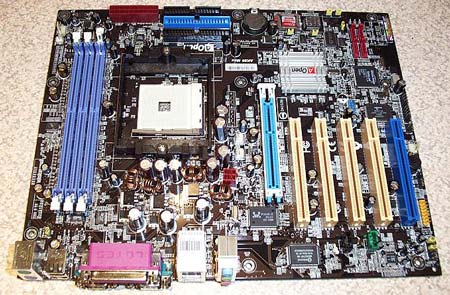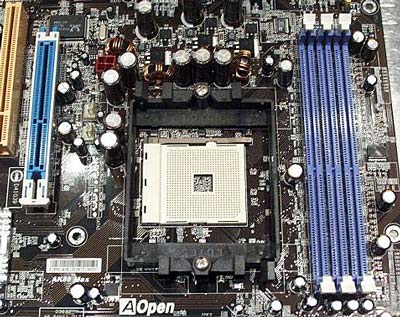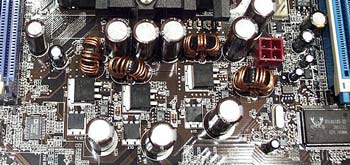AOpen AK89 Max: From Ugly Duckling to Swan
by Wesley Fink on April 21, 2004 4:16 PM EST- Posted in
- Motherboards
AOpen AK89 Max: Board Layout
Sleek and all-black have become the standard for recent AOpen boards, and the black AK89 Max looks great combined with the included black ide/floppy cables. The AK89 is a full-size ATX board with the standard 9 mounting holes.
Layout of the AK89 is quite different from most standard ATX boards. The memory slots are located at the top of the board in a tower case instead of the more common location, right of the CPU. The CPU socket is also in the top center of the board. Despite the different layout, the AK89 worked quite well in our mid-tower case with everything very accessible. The extra space on the full-size ATX board removes most of the complaints that we had in the similar layout of the AOpen AK86-L.
Athlon 64 boards use a standardized ATX plus 12V connector arrangement that is identical to the power connector requirements of current Pentium 4 systems. We generally prefer the connectors together on the upper right of the board, but the AK89 has placed both the 20-pin ATX at the top right and the 4-pin 12V at the middle of the board left of the CPU socket. This arrangement actually works well with the CPU socket in the top center of the board. The heavy 20-pin is completely clear of the CPU and IDE/floppy connectors.

With the memory slots at the top of the board, there is no possible interference of the AGP slot. Adding and removing memory was very easy with this arrangement. There is nothing nearby to interfere with easy memory access. However, very small case designs with a power supply overhanging the CPU area on a standard board could be a big problem with this DIMM placement.

As a top-end board, the AK89 Max gets a top-end, 3-phase power design with 4 coils. We like the fact that AOpen also uses the large 3300µF capacitors for voltage stability. While the capacitors are near the Socket 754, we had no trouble mounting a huge Zalman 7000 for CPU cooling.

The Primary/Secondary IDE and floppy connectors are located on the preferred upper right of the board. This will not be a problem in almost any case design. The connectors are well clear of the memory slots, power connector, and expansion slots.

The slide for locking the 8X AGP slot was easy to use - even with huge overhanging cards like the GeForce FX5950U. Most boards use the push-to-release lock, but that design becomes difficult to use with a large card. The 5 PCI slots include a blue PCI slot with a separate power supply. Those with a power-hungry PCI card will appreciate the extra stability of the dedicated power design for this slot.










23 Comments
View All Comments
retrospooty - Friday, April 23, 2004 - link
Am I the only one that found this artcle hard to follow ? Its all over the place ... What the hell was being tested ?cowdog - Thursday, April 22, 2004 - link
Thanks for the information.BTW, I finally did get through to AOpen, and they have been very prompt and helpful. I must have fallen through the cracks or something earlier.
Wesley Fink - Thursday, April 22, 2004 - link
Cowdog -I used our standard Mushkin/OCZ 3500 at default speed. Above 233, I used OCZ 3500EB to DDR500, and OCZ 4200EL to DDR550. if you look closely at the screen shots the memory is identified on the overclocks. As you state, BH6 can't reach these levels.
AOpen tells us the board would require a revision to allow an increase in vcore, and with the nF3-250 near, a new rev will not appear with the 150. They can't modify the vCore on this board with just a BIOS update. vdimm and higher FSB may be a possibility - we have requested those changes - but it is more likely these will come with the 250 version.
cowdog - Thursday, April 22, 2004 - link
FYI: This seemed as good a place to post this as anywhere else. Just came across a new bios, 1.07"For AMD recommended,memory clock will set to DDR333 when DIMM1 and DIMM2 plugged double side DDR400 memory."
Two things:
1. BIOS defaulted to 200x11 for me, which isn't a good thing for an A64 3200
2. I have no option for DDR400 in the bios with 2x246MB Mushkin Lv II PC3500.
3. When I tried to lower the multipler, the bios gave me an error at POST (safe mode or something like that). Then even if I selected bios defaults I had the same message. I reset cmos and it worked, although cpu frequency went back to the 200x11.
Might want to be leary of bios 1.07, although my system may simply be whacked.
cowdog - Thursday, April 22, 2004 - link
Wesley, I must admit that I haven't tried Dr. AOpen; I missed that. I did fill out their tech support form (with serial number, etc.) three times. This third time (last night) I did receive an automated reply for the first time. I kept screen shots of the previous forms, and I know my email was right. I'm not sure what happened. Anyway, I'll try Dr. AOpen as well, thanks.Couple of things to add:
1. As far back as the official 1.06 bios, I was able to change multiplers (only downward, of course) using Clockgen. I found that clockgen would work if I set the multiplier lower in the bios, even though that did not change the multiplier at post. 1.06 m bios now changes the multiplier at post, as you note. Funny thing too, after I updated to 1.06m, the default multipler was 4.
2. I don't understand why AOpen won't open up the cpu and dimm voltages as they did with the AK86-L. As you note, the AK89 Max is their current A64 flagship. Why add features via bios update to the AK86-L but not do similar for the AK89 Max? Unless, of course, those features can't be added with a bios update. Do you know?
3. When you overlclocked the memory 1:1 to 250Mhz, were you using the OCZ or Mushkin memory that you referenced earlier in the article? I am unable run some Mushkin BH-5 memory 1:1 at anything higher than 230Mhz (clockgen) and 210Mhz (bios) with the multiplier way down and LDT at 3 or 2.5 even though I can run the same memory at speeds higher than 250Mz on another board. Same thing with some Corsair LL v.1.1 memory. Just curious. Perhaps the cpu is the limiting factor; is there that much variability?
Anyway, thanks for a really nice and thorough review. I am trying very hard to like this board (and AOpen) and your review renewed my motivation.
Wesley Fink - Wednesday, April 21, 2004 - link
#7 - The Asus K8V is based on the VIA K8T800 chipset which has no capability at all for a PCI/AGP lock. We have found the performance of the VIA and nForce3-150 to be about the same at stock speed, but the VIA is simply not cpable of avchieving the overclocks we have reported in this review.The K8V performs about like the MSI K8V Neo which is included in our benchmarks.
Modal - Wednesday, April 21, 2004 - link
I wish you would have done some comparisons with the ASUS K8V Deluxe as well, as this seems to be quite a popular board for Athlon64 machines (plus, I'm thinking about using it for my next build...). Oh well...Wesley Fink - Wednesday, April 21, 2004 - link
#5 - Have you tried Dr. AOpen on line? If nothing has worked please email me your details and I will forward your email to contacts at AOpen.Both Evan Lieb and I have had very positive Support expereinces with AOpen. If others are getting different treatment it is important to know that and report it in our reviews.
gimpsoft - Wednesday, April 21, 2004 - link
is this a Real AGP /PCI lock ???i heard there way to mod the bios to lock but not the same as hardware Agp/pci locks
well something like a sofmod ill see if i can find the link
may be a this must buy board i got a via KT800
i can do 3000+ 10 X 250= 2500MHZ but my radeon 9800pro & audigy bitch they say to high =) PCI: 41 APG: 83
bigtoe33 - Wednesday, April 21, 2004 - link
2-I was quite impressed by te FSB's the AOpen was able to hit and did feel the review was there just to show what the board is capable of.I also have this board and i would say 1:1 will be pretty limited due to 2.8V vdimm max.
Also it was nice to see a comparison of 3dmark although i know this is not a bench Wes uses.
Overall i think the review showed the board has awesome potential and proved that boards can become awesome with a "tuned" bios ;-)